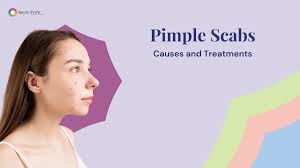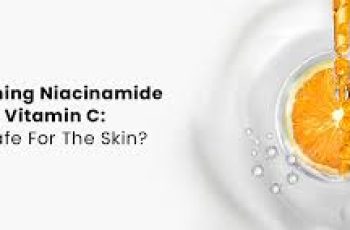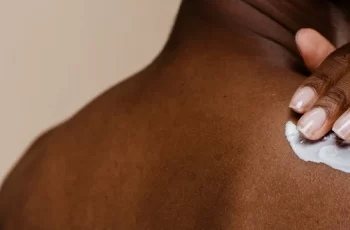
Pimple Scab: How to Heal Acne Scabs
Pimple scabs are ugly and hard to cover with makeup. They often look worse than the pimple itself. This is one of the many reasons why picking acne lesions is a bad idea. If you do not pick your pimples, many of them will heal without a scab. But what do you do if you picked pimples overnight or just could not resist popping them when you looked in the magnifying mirror? I am going to share with you tips for healing acne scabs that I give to my dermatology patients. This blog will discuss what pimple scabs are , how to treat them, and how to heal them faster.
How to Heal a Pimple Scab
When you pick or pop a pimple, a wound forms. Healing an acne scab will follow the same process of healing that any type of wound follows. To speed healing-do proven scientific things that have been shown to heal wounds faster. These are some strategies to heal pimple scabs fast. They probably won’t go away overnight, but following this advice that I give to my patients can help speed healing of any types of wounds including pimple scabs.
Colloidal dressings, ointments, hydrocolloid bandages, and even simple band-aids help hold in moisture and growth factors needed for optimal wound repair. This creates a moist, protected environment.
The occlusion traps cytokines and growth factors released by platelets, macrophages, and other cells involved in wound healing. This allows higher local concentrations around the lesion.
The moist environment also provides ideal conditions for new cell migration and proliferation across the wound. It prevents cell and tissue dehydration that slows epithelialization.
In addition, the dressings shield the scab from disruption. This allows fibroblasts time to rebuild collagen matrix and epithelial cells to fully resurface and reattach.
Finally, antibiotic ointments prevent bacterial contamination of the open wound underneath the scab. This reduces inflammation and facilitates faster healing.
In summary, occlusive dressings reinforce and protect acne scabs while maintaining ideal moisture levels for the stages of repair to occur. This helps prevent scarring by promoting faster, stronger healing.
Skin Care Products
Keeping a pimple scar covered speeds healing. Whether you use a Band-Aid, acne patch, colloidal dressing, Tegaderm, a silver gel or an ointment, the wound will heal faster than if it is allows to dry out uncovered.
Healing Ointments
Any ointments that do not have the ingredients discussed below can speed healing including Vaseline and Aquaphor.
Ointments that speed wound healing:
[[PP12]]
Serums
Serums that do not have ascorbic acid, retinol and hydroxyacids can speed up the healing of acne scabs.
Cleansers Safe To Use on Acne Wounds
Soothing and post procedure cleansers can be used to clean the skin that has an acne scar. But make sure you use very gently with minimal friction so thee scar is not irritated.
[[C05]]
Antibacterial cleansers are also a good choice.
[[C08]]
Using the right skin care products can help prevent acne pimples, so make sure you are using the best medical grade brands that are right for your Baumann Skin Type.
What to Avoid on Acne Scabs
A scab is the skin’s way of protecting a wound so that healing can take place underneath. This means that you want to leave the scab on and protect it. Picking off a scab dramatically slows healing.
You need to protect the scab and let it stay on as long as possible. I know it is tempting to pull it off, but that makes everything take longer and can lead to scarring. So protect your scabs.
Decrease friction
Decrease friction to the scab to allow it to stay on longer.
Avoid all sources of friction such as:
Kissing someone with a rough beard
Exfoliating scrubs
Face brushes
Loofas
Rubbing with a rough towel
Scratching
Avoid products that speed exfoliation
Exfoliation and desquamation are the skin’s natural process of renewing itself. When a wound is healing, and it still has a scab, you do not want to artificially speed up this process.
When you have a scab avoid using:
ascorbic acid
low pH cleansers
retinoids
Avoid ingredients that slow wound healing
You will heal faster if your desquamation cycle (also called cell cycle) process is going faster before the injury, because you replace new cells faster. However, but if you try to speed up exfoliation after you have a scab, it can make the scab go away too soon and slow healing. So there are a few ingredient that you want to use before a wound but not after a wound. In other words, if you were using these before you got the acne pimple, you will heal faster. But- if you put these on a acne scab, you will heal slower. Confusing? I know. Keep reading to hear more details.
Witch Hazel
Many people tell you to put witch hazel on a pimple scab to heal it faster but this is not good for acne wounds because the tannins in witch hazel cause vasoconstriction and decrease blood flow to the area. Witch hazel actually slows healing and can make the scab tingle so you are more likely to scratch it. Do not use witch hazel on an acne scabs.
Witch hazel contains tannins and other plant compounds that can potentially disrupt or delay wound healing when applied topically to acne lesions or pimples. Here are a few ways it can negatively impact the healing process:
Vasoconstriction – Witch hazel can cause blood vessels to constrict. This reduces blood flow to the area and delays the inflammatory phase by limiting delivery of platelets, immune cells, and nutrients needed for repair.
Cell toxicity – Tannins and other witch hazel compounds can be directly toxic to cells like fibroblasts that are trying to proliferate and rebuild damaged tissue. This slows down the proliferative phase.
Drying effect – The astringent nature of witch hazel can dry out wounds. This causes dead tissue buildup and peeling of the protective scab too early. It also creates a poor environment for new cell growth.
Collagen inhibition – Witch hazel may interfere with collagen synthesis by fibroblasts. This weakens the structural integrity of the healed wound and increases risk of scarring.
Oil reduction – Sebum is needed for moist wound healing. By reducing oil, witch hazel may slow re-epithelialization of the damaged pilosebaceous gland.
So while witch hazel may temporarily reduce inflammation due to its antioxidant and anti-irritant properties, it likely impedes the later stages of healing. Acne lesions heal faster when kept moist and protected, allowing the natural healing process to occur.
Retinol
Retinol
Retinoids like tretinoin work by increasing cell turnover and collagen production in the skin. However, when applied to an existing acne wound or scab, they can disrupt the normal healing stages.
Retinoids inhibit certain matrix metalloproteinases like collagenase that are needed to remodel collagen during the proliferation phase. They also reduce transglutaminase, an enzyme that crosslinks collagen fibers to add strength. This weakens the wound matrix.
Retinoids also impair keratinocyte migration and epidermal growth factor secretion required for re-epithelialization. This delays resurfacing of the lesion.
Additionally, retinoids speed up shedding of the protective scab before the underlying tissue has sufficiently healed. This removes the scaffolding the new cells need to close the wound.
Paradoxically, when retinoids are used before an injury, they help accelerate wound strength and closure. But applying them after the wound has formed causes issues.
In summary, retinoids disrupt collagen formation, slow cell growth, and peel off scabs too quickly when applied to existing acne lesions. This delays healing and increases chances of scarring. So it’s best to avoid retinoids on open acne wounds until after they have fully closed.
Salicylic acid
Salicylic Acid
Salicylic acid works as a chemical exfoliant and is often used to treat acne. However, when applied to an active acne lesion or scab, it can impair healing:
Salicylic acid has a low pH which can chemically dissolve or detach scabs before the wound has closed. This leaves the underlying tissue unprotected.
It acts as an anti-inflammatory by inhibiting prostaglandins. But some inflammation is needed to signal immune cells and growth factors that facilitate wound repair.
The exfoliating properties also cause excess shedding of skin cells around the wound. This can remove viable cells trying to proliferate and resurface the lesion.
Salicylic acid may disrupt fibroblast function and reduce collagen production needed for wound strength.
The drying effects of salicylic acid create a less optimal environment for new tissue growth and epithelialization.
While salicylic acid helps prevent new acne, applying it after a pimple forms can delay healing stages, especially the migratory and proliferative phases. This increases the chances of scab loss, discoloration, and scar formation.
In summary, it is best to avoid salicylic acid on open acne wounds until after the lesion has fully closed. Letting the pimple heal naturally helps prevent damage that can occur from early scab removal.
Vitamin C
Vitamin C
ascorbic acid (vitamin C) should not be applied to open acne wounds or scabs:
Ascorbic acid has a low pH, usually between 2-3. This acidic environment can be very irritating to freshly damaged skin and inhibit wound healing.
The low pH can cause chemical irritation and burning of the exposed lesion underneath the scab. This creates more inflammation which delays the healing cascade.
Acidity can also destabilize and prematurely dissolve the protective scab covering the wound. This leaves the vulnerable tissue unprotected before it has sufficiently healed.
Ascorbic acid can be cytotoxic to newly forming collagen fibers and granulation tissue inside the wound when applied too soon. This disrupts the proliferative phase.
The irritation and inflammation caused by the acidity generates more free radicals. This worsens oxidative damage rather than utilizing vitamin C’s antioxidant effects.
Additionally, ascorbic acid can reduce natural oil production around the wound. This drying effect inhibits epithelialization.
In summary, the low pH and irritating properties of ascorbic acid can impair acne wound healing when used too soon. It’s best to allow scabs to naturally fall off before applying topical vitamin C to help fade post-inflammatory erythema.
Stages of healing for acne scabs
Stages of Healing for Acne Scabs
The 3 main stages of wound healing applied to acne pimples:
Inflammatory Phase (1-3 days)
When an acne pimple ruptures, the damaged hair follicle and sebaceous gland bleed. Platelets rush to the area and form a fibrin clot to stop the bleeding. Inflammatory cells like neutrophils arrive to fight bacteria and clear debris. This causes swelling, redness and pus.
Proliferative Phase (4-10 days)
Fibroblasts form granulation tissue inside the acne lesion. New blood vessels develop to deliver nutrients and oxygen. Fibroblasts produce collagen to strengthen the damaged follicle and seal the ruptured gland. Epithelial cells from hair follicles and sebaceous glands regenerate and migrate to resurface the lesion.
Maturation Phase (10-14 days)
Fibroblasts continue remodeling collagen to close the lesion. The epithelial layer covers the healing tissue and reforms attachments between the skin layers. A scab forms from dried inflammatory fluid, collagen, and cellular debris. The scab flakes off as healing completes. Some red or brown discoloration may remain.
The timing depends on the severity of the rupture.
These phases of healing prevent scarring by restoring the anatomy and function of the pilosebaceous unit. Picking or popping pimples can disrupt these wound healing stages, slow healing, and increase the risk of scarring.
Why Acne Scabs Won’t Heal
Scabs won’t heal if exposed to friction, picking, or some of the ingredients mentioned above. Also, i you are over 70 years old, teh skin heals slower.
The microbiome and other issues can also be the cause of pimple scabs that do not heal.
The microbiome and skin healing
Microbiome and Skin Healing
Acne scabs may fail to heal properly when there is an imbalance in the natural microbiome of the skin. Healthy commensal bacteria play an important role in optimal wound healing after an acne lesion ruptures. However, disruption of the microbiome can prevent the normal repair process from occurring. Opportunistic bacteria like Staphylococcus aureus can overcolonize the open wound, forming biofilms that cause chronic inflammation. This impairs healing by preventing immune cells from clearing debris and inhibiting the proliferative phase. On the other hand, commensals like Staphylococcus epidermidis help initiate pathways that reduce inflammation while accelerating tissue regeneration. Therefore, acne scabs may not heal due to a disturbed microbiome that lacks the beneficial bacteria needed to modulate the immune response and promote wound closure. Proper acne wound care helps maintain a balanced microbiome to facilitate normal healing.
If you get on the right skincare products for your Baumann Skin Type, you are much less likely to get pimples. Take the skin type quiz and we will tell you what skincare products are right for your skin type.


